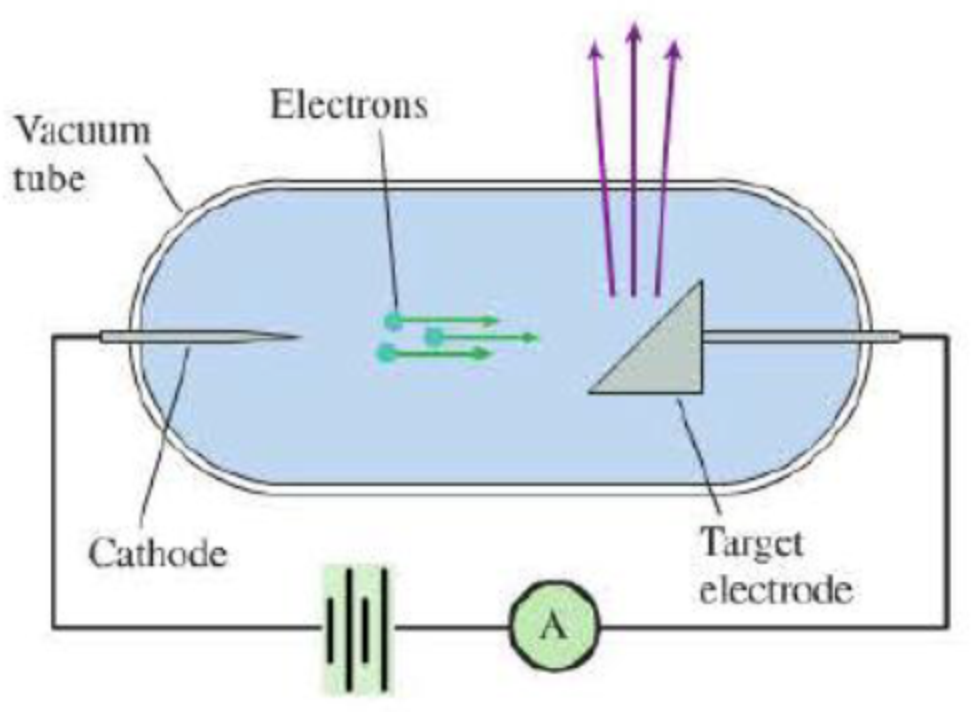
Concept explainers
The following passages and associated questions are based on the material of Part VI
Taking an X Ray
Cathode Turret electrode
 X rays are a very penetrating form of
X rays are a very penetrating form of
FIGURE VI.1

A schematic view of an x-ray tube and a driver circuit is given in Figure VI.1. A filament warms the cathode, treeing electrons. These electrons are accelerated by the electric field established by a high-voltage power supply connected between the cathode and a metal target. The electrons accelerate in the direction of the target. The rapid deceleration when they strike the target generates x rays. Each electron will emit one or more x rays as it comes to rest.
An x-ray image is essentially a shadow; x rays darken the film where they pass, but the film stays unexposed, and thus light, where bones or dense tissues block x rays. An x-ray technician adjusts the quality of an image by adjusting the energy and the intensity of the x-ray beam. This is done by adjusting two parameters: the accelerating voltage and the current through the tube. The accelerating voltage determines the energy of the x-ray photons, which can't be greater than the energy of the electrons. The current through the tube determines the number of electrons per second and thus the number of photons emitted. In clinical practice, the exposure is characterized by two values: “kVp” and “mAs.” kVp is the peak voltage in kV. The value mAs is the product of the current (in mA) and the time (in s) to give a reading in mA · s. This is a measure of the total number of electrons that hit the target and thus the number of x rays emitted.
Typical values for a dental x ray are a kVp of 70 (meaning a peak voltage of 70 kV) and mAs of 7.5 (which comes from a current of 10 mA for 0.75 s, for a total of 7.5 mAs). Assume these values in all of the problem that follow.
What, physically, does the product of a current (in mA) and a time (in s) represent?
- A. Energy in mJ
- B. Potential difference in mV
- C. Charge in mC
- D. Resistance in mΩ
Want to see the full answer?
Check out a sample textbook solution
Chapter P Solutions
College Physics: A Strategic Approach (4th Edition)
- Please please help me I will rate good for you even if it’s incorrect.arrow_forwardPart D: Conclusions 28. Do the experimentally determined capacitance measurements match the value marked? Are they close? 29. Would the capacitor discharge more quickly or more slowly if we had used a capacitor with a smaller value of capacitance? Explain. 30. Why does the capacitor charge almost instantly when the switch is closed? 31. Why does the capacitor discharge more slowly when the switch is opened compared to charging?arrow_forwardDistance QUESTION 2 What is the difference between speed and velocity? Speed is a scalar quantity where as the velocity is a vector quantity. Speed is a vector quantity where as the velocity is a scalar quantity. There is no difference between speed and velocity. Speed is the rate of change of velocity QUESTION 3 The maximum number of electrons in the 2nd shell of an atom isarrow_forward
- An oil drop whose mass is determined to be 2.8x10-15 kg is held at rest between two large plates separated by 1.4 cm as in the figure. (Figure 1) Part A If the potential difference between the plates is 390 V , how many excess electrons does this drop have? Express your answer as an integer. ? n = excess electrons Submit Request Answer Provide Feedback Figure 1 of 1 Atomizer Droplets - Telescopearrow_forwardPlease help with correct decimal.arrow_forwardNeeds Complete typed solution with 100 % accuracy.arrow_forward
- The diagram below illustrates an experiment with electrons. A beam of electrons iscreated using an electron gun, and deflected using an electric field. i.Explain how the electron gun creates a beam of electrons. Add to the diagramif that will help your explanation.ii.The electric field which deflects the beam is created by applying a potentialdifference of 2500 V across plates 9.0 cm apart. Show that the verticalacceleration of the electrons due to this field is about 5 × 1015 m s–2arrow_forwardPlease answer the first 3 questions as per guidelinesarrow_forwardNon graded need help with practice q from textbookarrow_forward
- Please answer 1 2 and 3arrow_forwardPart A If a proton and an electron are released when they are 2.50x10-10 m apart (typical atomic distances), find the initial acceleration of each of them. Express your answer in meters per second squared. delectron = m/s? Submit Request Answer Part B Express your answer in meters per second squared. ? Aproton = m/s? Submit Request Answerarrow_forwardcontinued to task 1arrow_forward
 Glencoe Physics: Principles and Problems, Student...PhysicsISBN:9780078807213Author:Paul W. ZitzewitzPublisher:Glencoe/McGraw-Hill
Glencoe Physics: Principles and Problems, Student...PhysicsISBN:9780078807213Author:Paul W. ZitzewitzPublisher:Glencoe/McGraw-Hill
